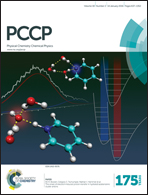On the explanation of hysteresis in the adsorption of ammonia on graphitized thermal carbon black
Abstract
We present a Monte Carlo simulation and experimental study of ammonia adsorption on graphitized thermal carbon black. Our new molecular model for the adsorbent is composed of basal plane graphene surfaces with ultrafine pores grafted with hydroxyl groups at the junctions between graphene layers. The simulated adsorption isotherms and isosteric heats are in good agreement with the experimental data of Holmes and Beebe, and the simulations reproduce the unusual experimental hysteresis of ammonia adsorption on an open graphite surface for the first time in the literature. The detailed mechanisms of adsorption and desorption, and the origin of hysteresis, are investigated by the microscopic analysis of the adsorbate structures to show that restructuring occurs during adsorption. The main results from this work are: (i) at the triple point, ammonia adsorbs preferentially around the functional groups to form clusters in the ultrafine pores and spills-over onto the basal plane as the loading is increased; followed by a 2D condensation on the graphite surface to form a bilayer adsorbate; (ii) at the boiling point, adsorption occurs on the basal plane due to the increasing importance of thermal fluctuations (an entropic effect); (iii) the isosteric heat is very high at zero loading due to the strong interaction between ammonia and the functional groups, decreases steeply when the functional group is saturated, and eventually reaches the heat of condensation as the fluid-fluid interaction increases.


 Please wait while we load your content...
Please wait while we load your content...